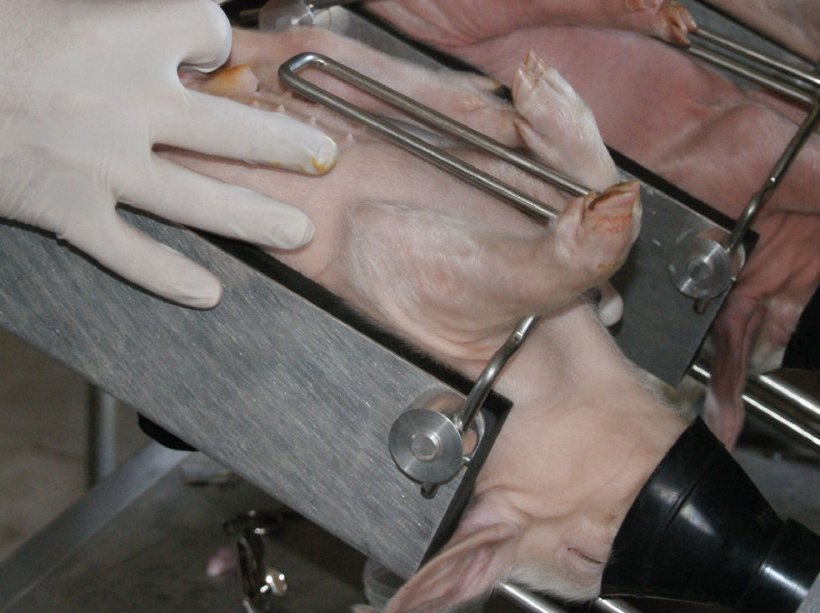As of January 1, 2021, castration of piglets in Germany is only allowed under general anaesthesia (not local anaesthesia, not pain mitigation). The new regulations allow farmers and other knowledgeable persons to administer general anaesthesia via inhalation of isoflurane.
This new situation makes us curious to know how this methodology is being implemented in the second largest pig producing country in the European Union. That is why we contacted Sven Häuser, Division Manager of Livestock Farming & On-farm Operations at DLG Competence Center for Agriculture and Manager of the European Pig Producers Club, to learn more about the implementation of the system.

According to Häuser, before the new regulations were implemented, an estimated 5% of male piglets were intact, 5% of male piglets were immunocastrated, and 90% of male piglets were castrated.
Now piglet producers in Germany must choose one of the following options:
- Finishing of intact boars
- Finishing of immunocastrated boars
- General anaesthesia methods:
- Ketamine/azaperone injection administered by the veterinarian
- Isoflurane inhalation anaesthesia administered by trained farmers or personnel
The method has to fulfill the requirements of the demand. A large number of pigs in Southern Germany are sold directly to butchers that are processing pork with a special need for intramuscular fat and without any boar taint. Such finishing farms prefer castrating piglets.
In Germany there is a “quality market” which makes up 10% of the market and has label programmes, driven by factors such as animal welfare, and was already using the system of castration under anaesthesia. The other “global market” makes up the remaining 90%. The average slaughter weight of hogs in Germany is about 96 kg. The weight depends more on the general market situation relating to price level.
In regards to the use of isoflurane anaesthesia (Fig. 1), it is estimated that 45% of all male piglets are castrated under isoflurane currently in Germany. The fact that the new regulations allow the farmers to administer the anaesthesia themselves has increased its use. But the increase is also a result of the financial support by the Agricultural Ministry for the acquisition costs for the anaesthesia machines.

Advantages and disadvantages of using inhalation anaesthesia
The ability to anesthetize piglets with isoflurane allows famers to carry out the process themselves once they have completed the appropriate training. This is one of the main advantages of this method over others. The training encompasses a 12-hour theoretical training module and a practical phase under the guidance of a veterinarian. On the other hand, general anesthesia methods such as injections with ketamin / azaperon can only be administered by veterinarians. Another advantage is that the Ministry of Agriculture provides financial support for the purchase of the equipment, so that the purchasing costs are reduced. The government funded the purchase of devices which resulted in 4,159 farmers out of a total of 7,000 farmers with breeding animals receiving these devices. Some 60% of farmers chose this system.
The German Agricultural Society (DLG) certified five different devices for anesthesia with isoflurane. All five devices are ready to use with the advantages and disadvantages summarized for each system provided by DLG test reports.
DLG has also published two "Expert Knowledge" papers in German regarding piglet castration with isoflurane or injectable anesthesia. These papers are written for German farmers:
- Piglet castration under inhalation anesthesia: How do I optimize my workflow?
- Piglet castration under injection anesthesia: How do I optimize my workflow?
It is up to the farmer and the farm structure to choose the device which best fulfills the personal needs and wants.
As for the disadvantages, the additional cost to the producer must be taken into account, which includes the depreciation and maintenance costs of the equipment (technical costs) as well as the costs for additional labor time spent on each piglet, which increases because the time spent on the castration itself is added to the time spent handling the anesthesia (transport to and from the area where we have the anesthesia equipment, monitoring of the animals after the anesthesia period...) (Table 1). In addition, only 2 to 4 piglets can be treated at the same time with the same device.
Table 1. Additional costs of anesthesia with isoflurane compared to castration without anesthesia for different types of farms according to their size and location. (Source: BLE based on data from Thünen Institut)

| Bavaria (n=170 sows) | North Rhine-Westphalia (n=350 sows) | Schleswig-Holstein (n=850 sows) |
Saxony-Anhalt/ Thuringian (n=2490 sows) |
|
|---|---|---|---|---|
| Additional time (min/piglet) | 5.26 | 5.06 | 4.96 | 5.08 |
| Technical costs (€/piglet) | 0.99 | 0.44 | 0.16 | 0.06 |
| Costs for the drug dosage (€/piglet) | 0.48 | 0.48 | 0.48 | 0.48 |
| Additional costs of inhalation anesthesia performed by the farmer(€/piglet) | 3.02 | 2.61 | 1.90 | 1.94 |
Producers in Lower Saxony and North Rhine-Westphalia asked for a surcharge of €4 per castrated piglet. According to Häuser, it is included in the contract of the piglet producer and the finishing farm if a surcharge has to be paid.
On the other hand, Germany imports a large number of piglets and animals for slaughter. About 11 million piglets are imported in Germany every year: 6 million from Denmark and 5 million from the Netherlands. In regards to the question as to whether the conditions for castration in these countries are comparable, according to Haüser, the rules for these imported piglets are the same as for German piglets, protocols and controls are still in preparation.
When asked about the possible influence of the implementation of this system in Germany on the other EU countries and whether he expects any new regulations at the EU level in the short to medium term, Häuser said that although it would be optimal to have uniform regulations, he does not expect a new general regulation at the EU level.
As of January 1 of this year, it has been mandatory to effectively eliminate pain during castration in Germany. To avoid possible competitive disadvantages due to these stricter requirements, the law made it possible for farmers to perform this painless castration themselves by using isoflurane anaesthesia and also financed the farmers' purchase of the necessary equipment, in addition to holding informational events for farmers and communication campaigns so that consumers are well informed when purchasing pork.
333 Staff.





